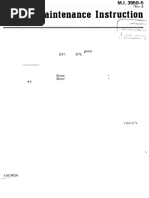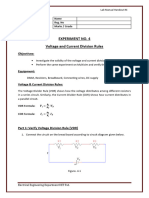Lab 1
Uploaded by
Fatin ChowdhuryLab 1
Uploaded by
Fatin ChowdhuryFaculty of Engineering Engineering Undergraduate Office Department of Electrical & Computer Engineering
GenE 123: Electrical Engineering
ME 123: Electrical Engineering for Mechanical Engineers
Laboratory 1: DC Concepts and Measurements
Contributors: Last Revision: Source:
DJ Brush, J Lowe, Z Zayouna January 2008 GE 123 Laboratory Manual, JD Aplevich, JD Cross, JD Leslie, MMA Salama, 1994
UW GenE/ME 123 Lab 1 Manual
2/11
1 Introduction
In this lab you will gain hands-on circuits experience by building simple DC circuits containing a power supply and resistors. You will also use two types of meters to measure resistance, voltage, and current. The remainder of this lab is divided into 4 sections: the Background which summarizes the circuit concepts studied in the lab; the Pre-Lab which presents exercises that must be completed prior to starting the lab; the Practical which presents the exercises performed in the lab; and the Lab Write-Up which is where all measured data and question answers are recorded. You will be required to hand in your Pre-Lab exercises and Write-Up at the end of the lab period.
2 Background
An electric circuit is a closed loop of circuit devices interconnected by conducting material. Figure 2.1 symbolically shows a Power Supply (PS) and a Resistor (R) connected by conducting wire. The PS provides the power to drive electric charge around the circuit in the direction of the arrow. The resistor resists the flow of charge and consumes the power supplied by the PS. The wire acts as a charge pipeline between the devices and is assumed to be a perfect conductor (i.e., no energy loss). Voltage, current, resistance, and power are fundamental circuit properties that are introduced below. This lab examines direct current (DC) circuits, which means that voltages and currents in the circuit will be constant in time.
+ VPS PS
+ VR R
Figure 2.1: Illustration of a simple circuit. Voltage: Voltage V is the difference in electric potential between two points in a circuit with units of joules/coulomb or J/C = volts or V. Voltage is expressed using a sign convention called polarity that labels the assumed higher voltage point with + and the lower voltage point with . For example, Figure 2.1 shows the polarity of the power supply voltage VPS, which indicates that the voltage at the top of the PS is higher than at the bottom. Note that it is possible to have a negative voltage, which means that the actual polarity is opposite to the one assumed. Current: Current I quantifies the movement of charge through the wires and devices in the circuit with units of C/s = amps, A. Current is mathematically defined as dq / dt which is the amount of charge dq moving past a point in the circuit over a time interval dt. Current direction is expressed using an arrow sign convention as shown in Figure 2.1. Note that it is possible to have a negative current, which means the actual current direction is opposite to the one assumed.
UW GenE/ME 123 Lab 1 Manual
3/11
Resistance: Resistance is the property of resisting current flow in a circuit. Circuit devices that are primarily designed to resist current flow are called resistors. The resistance R of a resistor is related to the voltage V across it and the current I passing through it by Ohms law:
V =I R
(Ohms law)
where I enters the high voltage (+) side of the resistor and leaves the low voltage () side. Rearranging Ohms law as R = V / I shows that the units of resistance are V/A = ohm or . Typically the units used with Ohms law are V = mAk. Resistors: Resistors are used to control voltage and current in circuits ranging from low power electronics to high power hydro grids. In this lab you will use carbon resistors with a fixed resistance that is coded on the resistor casing using 3 coloured bands. Figure 2.2 shows the band positions and labels. The first and second bands represent the first two digits of the resistance value. The third band is a multiplier (power of 10) that is multiplied to the two digits to give the total resistance value. In other words, the third band gives the number of trailing zeros. An optional forth band indicates the manufacturers tolerance (acceptable error) in meeting the encoded resistance. The digit, multiplier, and tolerance band colour codes are listed in Table 2.1.
Figure 2.2: Resistor bands. Table 2.1: Resistor band colour codes. Colour
Black Brown Red Orange Yellow Green Blue Violet Grey White Digit 0 1 2 3 4 5 6 7 8 9 Multiplier 1 10 102 103 104 105 106 107 108 109 Colour Gold Silver None Tolerance 5% 10 % 20 %
For example, a resistor having 4 bands coloured red-violet-orange-gold has a resistance of 27,000 with a tolerance of 5%.
UW GenE/ME 123 Lab 1 Manual
4/11
Power: Power P is the rate of energy supplied or consumed by a device in a circuit and is defined as P = V I with units of VA = J/s = W. Power is an expression of energy and is therefore conserved over all circuit devices. Power Supply: The power supply provides power (voltage and current) to the circuit. The PS used in this lab is a DC voltage source, which means that it supplies a constant user specified voltage. The PS supplies current to meet power demands of the rest of the circuit at the specified voltage, provided that the power rating and current limit are not exceeded. In other words, the PS sets the voltage and the rest of the circuit sets the current. Ohmmeter: An ohmmeter is a device that measures the resistance of an object. Voltmeter: A voltmeter (VM) is a device that measures the potential difference or voltage between two points in a circuit without significantly altering the circuit properties. In this lab you will use a voltmeter to measure the voltage across a resistor as shown in Figure 2.3. The voltmeter is connected in parallel with the resistor and seems to provide another path for the current. However, voltmeters have a very large internal resistance, so that very little current flows through the device.
I
PS
VPS
VR
VM
Figure 2.3: Voltmeter connection across a resistor. Ammeter: An ammeter (AM) is a device that measures current through a closed circuit loop without significantly altering the circuit properties. They must be connected in series with the circuit as shown in Figure 2.4. Ammeters have a very small internal resistance, so that the voltage across the device is very small. AM +
I
PS
VPS
VR
Figure 2.4: Ammeter connection in series with circuit loop.
UW GenE/ME 123 Lab 1 Manual
5/11 Due at Start of Lab Session (one per group) Attach Pre-Lab to your Write-Up
3 Pre-Lab
Ex. 1
Use the resistor colour code (see Table 2.1) to complete the following table: Resistor Colour Bands R (k) 1 5.1 8.2 10 20 30 100 Band 1 Colour Band 2 Band 3
Ex. 2 Figure 3.1 shows a simple circuit containing a power supply (PS) and a resistor (R) connected with conducting wire. The voltage polarity and current direction are also shown. On a separate piece of paper, perform and answer the following: (a) Use Ohms law to calculate the loop current I in mA given that the PS voltage VPS is 5 V and the resistor resistance R is 5 k. (b) Calculate the power consumed by the resistor. (c) Repeat (a) and (b) with R values of 10, and 20 k. (d) What do you notice about the calculated current and power values as R is doubled? (e) What would happen to the calculated currents if the source voltage was doubled?
I
PS
VPS
VR
Figure 3.1: Pre-lab circuit.
UW GenE/ME 123 Lab 1 Manual
6/11
4 Practical
Choose a lab partner (2 students per group). Obtain a lab kit and a portable Analogue Ammeter mounted on a board with 2 other devices. You will need several resistors, wire, the spring board, and pick for this lab. You will also use the Digital Multi-Meter and Power Supply mounted on your workstation. Ex. 1: Measuring Resistance using the Digital Multi-Meter (a) Find the Digital Multi-Meter (DMM) at your workstation. Remove the red and black cables or leads from the storage tube. Insert the red lead into the terminal marked k or and the black lead into the terminal marked common. Press the power button on. Press the button marked k to activate the ohmmeter (OM) functionality of the DMM. The range buttons influence the lowest and highest resistance values that can be read with the meter. A range set too high will display zeroes for all significant digits and a range set too low will display flashing numbers or 1 on the left side of the display. (b) Measure your own resistance. Firmly hold the metal end of each lead in each hand. Determine the appropriate range and read the DMM display. Record your resistance in the write-up section and answer the associated question. (c) Measure the resistance of various resistors. Using your Pre-Lab resistor colour table, find the following resistors in your kit: 1, 5.1, 8.2, 10, 20, 30, and 100 k. Mount the resistors onto the spring board by inserting the resistor wire connectors into different springs (use the pick supplied to separate the springs). Determine the appropriate range and measure the resistance of each resistor by connecting the DMM leads to the springs holding the resistors. Record the measured resistance values in the write-up exercise table. Complete the exercise table. Ex. 2: Building a Simple Circuit and Measuring Voltage and Current (a) Configure the DMM to function as a DC voltmeter (VM). It is very important to ensure that the meter is set for DC. The leads remain in the same terminals as in Ex. 1. (b) Examine the portable board containing 3 black circuit devices: a DC Analogue Voltmeter (labeled M1), DC Analogue Ammeter (labeled M2), and a Resistance Decade Box. We will be using only the Analogue Ammeter (AM) for this lab, which is also identified by the units of amps, mA on the needle gauge. This ammeter has two terminals marked + and , and a rotary dial for setting the measurement range (note that the numerical scales are printed on the gauge are associated with the range settings).
UW GenE/ME 123 Lab 1 Manual
7/11
(c) Identify the Goldstar GP105 Power Supply (PS) at your workstation. This PS is an independent voltage source, which will be used to supply a constant DC voltage to the circuit you will build. It has 3 terminals, but we will only use two: the + and terminals. Turn the current limiting knob all the way clockwise and turn the voltage knob all the way counter-clockwise. Press the button marked V so that the needle gauge will display the voltage supplied by the device. Keep the power off for now. (d) Build the circuit shown schematically in Fig. 4.1. Use the red and black leads and/or the wire supplied with your lab kits to connect the device terminals and the 1 k resistor mounted on the spring board as shown.
I
+
AM
+ V VM R = 1 or 20 k common
VPS
PS
VR
device terminal spring board connection cables/leads/wires Figure 4.1: Layout of simple DC circuit with Ammeter (AM) and Voltmeter (VM). (e) Power on the PS and slowly turn the voltage knob clockwise until the needle gauge reads 5 V (voltage supplied by PS). Record the AM current and the VM voltage readings in the exercise write-up table. Repeat this step for 10 and 20 V. (f) Power off the PS and replace the 1 k resistor with a 20 k resistor. Repeat step (e). (g) For R = 20 k and VPS = 20 V: Power off the PS. Switch the connections to the PS terminals. Power on the PS and observe the current and voltage readings. Record and explain your observations in the lab write-up. (h) Complete the Ex. 2 tables and questions in the write-up.
UW GenE/ME 123 Lab 1 Manual
Ex. 3: Measuring Meter Loading
8/11
Ideally an ammeter has zero resistance so that the when current flows through it the voltage across it is zero. However, a real ammeter has a small resistance and therefore a small voltage when current flows through it. (a) Measure and record ammeter current and voltage. Turn the PS off. Disconnect the VM from the resistor and connect it across the ammeter as shown in Figure 4.2. Note that the 20 k resistor is still used. Turn the PS on and set VPS to 30 V. Measure the current IAM using the AM and voltage VAM using the VM. Record these values in the lab write-up.
V VM IAM AM + VPS PS + VAM + VR 20 k common
Figure 4.2: Circuit layout to measure the AM voltage An ideal voltmeter has an infinite resistance so that zero current travels through the device. Real voltmeters have large resistances and small currents when connected into a circuit. (b) Measure and record the VM current and voltage. Disconnect the VM and AM and connect them across the resistor as shown in Figure 4.3. Measure the current IVM using the AM and voltage VVM using the VM. Record these values in the lab write-up.
I + + VPS PS + VR AM V VM
+ VVM
common
20 k
IVM
Figure 4.3: Circuit layout to measure the VM current. (c) Calculate the internal resistance of these two meters and answer the corresponding question.
UW GenE/ME 123 Lab 1 Manual
9/11
5 Write-Up
Group Data Name
Due at End of Lab Session (one per group) Please put your full name, program and block on the Write-Up & Pre-Lab Program Block TA Pre-Lab Signature
Ex. 1 Body Resistance Data
What factors might influence your body resistance?
List the buttons that must be pushed on the DMM to measure a resistance of 3 k.
Resistor Resistance Data Rband (k) 1 5.1 8.2 10 20 30 100 Tolerance (%) Rmeas (k) Difference (%)
100 (Rmeas-Rband)/Rband
Meets Spec (Y/N)
UW GenE/ME 123 Lab 1 Manual
Ex. 2 Rband = 1 k, Rmeas = VPS (V) 5 10 20 * Difference, = 100 (Icalc-Imeas)/Imeas Rband = 20 k, Rmeas = VPS (V) 5 10 20 * Difference, = 100 (Icalc-Imeas)/Imeas How do the measured and calculated currents compare? Explain any large differences. . VR-meas (V) Imeas (mA) Calculated Currents I1 = VPS / Rband I2 = VR-meas / Rmeas * (%) I2 (mA) * (%) I1 (mA) VR-meas (V) Imeas (mA) Calculated Currents I1 = VPS / Rband I2 = VR-meas / Rmeas * (%) I2 (mA) * (%) I1 (mA)
10/11
Record and explain your observations when the PS connections were switched.
UW GenE/ME 123 Lab 1 Manual
List the buttons that must be pushed on the DMM to measure a DC voltage of 100 V.
11/11
Explain the use of a mirror on the Analogue Ammeter.
Determine the maximum power that the PS can supply.
Ex. 3 Ammeter Loading Data VAM IAM Resistance RAM = VAM / IAM
DMM-Voltmeter Loading Data VVM IVM Resistance RVM = VVM / IVM
The DMM-VM resistance is actually 10 M. Compare and explain your calculated RVM.
You might also like
- LG LFX31945 Refrigerator Service Manual MFL62188076 - Signature2 Brand DID PDF71% (7)LG LFX31945 Refrigerator Service Manual MFL62188076 - Signature2 Brand DID PDF95 pages
- Hyundai Entourage Workshop Manual (V6-3.8L (2009) )100% (1)Hyundai Entourage Workshop Manual (V6-3.8L (2009) )5,639 pages
- Lab 04 - Voltage and Current Division RulesNo ratings yetLab 04 - Voltage and Current Division Rules6 pages
- Eec 115 Practical - Electrical Engineering90% (10)Eec 115 Practical - Electrical Engineering35 pages
- Laboratory Exercices For Analog and Digital Circuits Using NI ELVIS II NI Multisim 2No ratings yetLaboratory Exercices For Analog and Digital Circuits Using NI ELVIS II NI Multisim 2150 pages
- EEC 115 Electrical Engg Science 1 Practical100% (10)EEC 115 Electrical Engg Science 1 Practical29 pages
- Exp 2 Resistors, Ohm's Law, Power Rating and I-V Caharacteristic (2012)No ratings yetExp 2 Resistors, Ohm's Law, Power Rating and I-V Caharacteristic (2012)10 pages
- Introduction to Electrical Circuits Lab 1No ratings yetIntroduction to Electrical Circuits Lab 112 pages
- ETE 1112 - Basic Electrical Engineering Lab Manual100% (1)ETE 1112 - Basic Electrical Engineering Lab Manual27 pages
- Lab 1 Introduction To Workbench Apparatus: ObjectiveNo ratings yetLab 1 Introduction To Workbench Apparatus: Objective51 pages
- EE251 Note 1 - Introduction To Fault StudiesNo ratings yetEE251 Note 1 - Introduction To Fault Studies56 pages
- Department of Electrical Engineering: Faculty Member: Muhammad Zeeshan - Dated: - 17 Oct, 2020No ratings yetDepartment of Electrical Engineering: Faculty Member: Muhammad Zeeshan - Dated: - 17 Oct, 202024 pages
- Ee-113 Basic Electrical Engineering - 2011No ratings yetEe-113 Basic Electrical Engineering - 201186 pages
- DC Lab Exp 2 Student Manual (Fall 22-23)No ratings yetDC Lab Exp 2 Student Manual (Fall 22-23)6 pages
- DC Lab - Exp - 1 - Student - Manual (Spring 22-23)No ratings yetDC Lab - Exp - 1 - Student - Manual (Spring 22-23)11 pages
- Ee-116 Principles of Electrical Engineering - 2014No ratings yetEe-116 Principles of Electrical Engineering - 201496 pages
- Resistomat Model 2320-V001: Operation ManualNo ratings yetResistomat Model 2320-V001: Operation Manual29 pages
- Product - Support-Precor-Service Manuals-Commercial Treadmill-C956i (240 VAC) (Serial Code Z5)No ratings yetProduct - Support-Precor-Service Manuals-Commercial Treadmill-C956i (240 VAC) (Serial Code Z5)69 pages
- Dyna S Electronic Ignition Instructions: InstallationNo ratings yetDyna S Electronic Ignition Instructions: Installation5 pages
- LG 47ls4600-Ua Chassis La21b mfl67402828No ratings yetLG 47ls4600-Ua Chassis La21b mfl6740282844 pages
- 1sc0 June 2022 Ms Paper 6 2ph Edx Gcse Combined Science PhysicsNo ratings yet1sc0 June 2022 Ms Paper 6 2ph Edx Gcse Combined Science Physics20 pages
- LG LFX31945 Refrigerator Service Manual MFL62188076 - Signature2 Brand DID PDFLG LFX31945 Refrigerator Service Manual MFL62188076 - Signature2 Brand DID PDF
- Hyundai Entourage Workshop Manual (V6-3.8L (2009) )Hyundai Entourage Workshop Manual (V6-3.8L (2009) )
- Laboratory Exercices For Analog and Digital Circuits Using NI ELVIS II NI Multisim 2Laboratory Exercices For Analog and Digital Circuits Using NI ELVIS II NI Multisim 2
- Exp 2 Resistors, Ohm's Law, Power Rating and I-V Caharacteristic (2012)Exp 2 Resistors, Ohm's Law, Power Rating and I-V Caharacteristic (2012)
- ETE 1112 - Basic Electrical Engineering Lab ManualETE 1112 - Basic Electrical Engineering Lab Manual
- Lab 1 Introduction To Workbench Apparatus: ObjectiveLab 1 Introduction To Workbench Apparatus: Objective
- Department of Electrical Engineering: Faculty Member: Muhammad Zeeshan - Dated: - 17 Oct, 2020Department of Electrical Engineering: Faculty Member: Muhammad Zeeshan - Dated: - 17 Oct, 2020
- DC Lab - Exp - 1 - Student - Manual (Spring 22-23)DC Lab - Exp - 1 - Student - Manual (Spring 22-23)
- Ee-116 Principles of Electrical Engineering - 2014Ee-116 Principles of Electrical Engineering - 2014
- Employability Skills: Brush up Your ElectronicsFrom EverandEmployability Skills: Brush up Your Electronics
- Product - Support-Precor-Service Manuals-Commercial Treadmill-C956i (240 VAC) (Serial Code Z5)Product - Support-Precor-Service Manuals-Commercial Treadmill-C956i (240 VAC) (Serial Code Z5)
- Dyna S Electronic Ignition Instructions: InstallationDyna S Electronic Ignition Instructions: Installation
- 1sc0 June 2022 Ms Paper 6 2ph Edx Gcse Combined Science Physics1sc0 June 2022 Ms Paper 6 2ph Edx Gcse Combined Science Physics

























































































